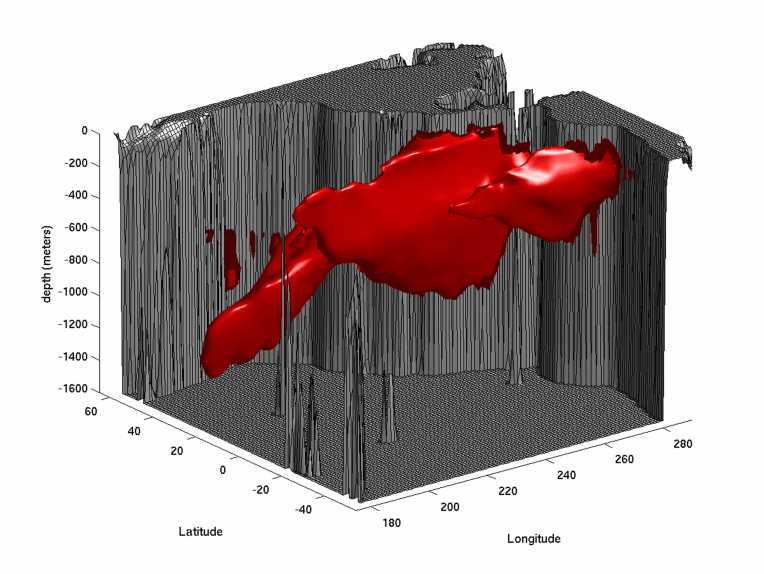[Top Image Credit: Image © Science/AAAS] [Caption: A 3-dimensional rendering, in red, of the observed structure of the low-oxygen region in the Eastern Pacific. The red "tongues" of low-oxygen water extend several thousand kilometers westward from the coasts of the continents between 100-1000 meters depth. The gray areas represent the ocean bottom and land areas (N. and S. America).]
The story of the world's oceans is a convoluted one - a massive churning cycle of cold and warm waters, that covers the much of the planet, and which overturns over hundreds of years. Huge eddies from storms swirl to the depths; water levels rise where warm water swells up - and then plunges where cold salty water sinks. And within that complex watery maelstrom, scientists have recently picked up worrying signs of growing 'dead zones', where oxygen levels fall below that needed to support many sea creatures.
Now oceanic scientist have published a paper, in today's Science, which shows that low-oxygen zones can be included in eddying complex that lurks beneath the oceans surface. They have developed computer models of the evolution of pockets of oxygen-poor waters, in three-dimensions. These show that they extend far below surface, expanding and contracting in response to bacteria and temperature.
The study of the ocean's oxygen levels is incredibly important, in this era of ongoing man-made climate change. Scientists have long predicted that as the globe warms - and the ocean's waters gradually follow suit - that the level of oxygen dissolved in the seas will fall. That's because cold water can hold much more dissolved oxygen within it - and very warm waters can become so depleted in oxygen that marine life vacates them entirely.
As the oceans oxygen levels lower, the concern is that marine life will be pushed into tighter and tighter oxygen-rich refuges, as the dead zones expand. There has been evidence that this may already be happening, with signs that low-oxygen areas are expanding in some parts of the Pacific. But this new study indicates that the picture is not a simple as a gradual throttling of life from the oceans - because oxygen poor zones are undergoing a long-term natural variation.
That may even see dead zones shrinking, at least in the short-term. One of the factors that the team have discovered, as driving the ebb and flow of low-oxygen zones, is bacteria. When oxygen levels are falling, a preponderance of 'respiring bacteria' seems to develop. These suck up more oxygen from the waters. But as warm waters cool and sink, the bacteria become less able consume oxygen, allowing oxygen levels to recover.
Ultimately it is likely that the dead zones will increase, as global warming takes its toll. But the paper suggests that this will happen over hundreds of years, rather than decades. That is good news for the oceans, which are already fending off a burgeoning number of man-made problems. But as with many things in the swirling oceanic abyss, we are probably only just dipping our toes in, when it comes to our understanding of the sea's oxygen cycles.










